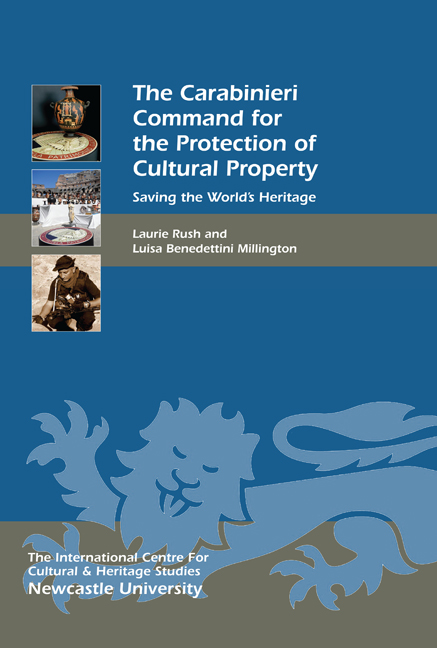Book contents
- Frontmatter
- Contents
- List of Illustrations
- Acknowledgments
- Foreword (in English and in Italian): Brigadier General Mariano Mossa
- Prefazione
- Abbreviations
- 1 The Carabinieri TPC: an Introduction and Brief History. Perché l’Italia? Why Italy?
- 2 Headquarters, the Databank and Operative Department in Rome
- 3 Carabinieri Public Outreach and Education
- 4 Central Italy and the Adriatic: Lazio, Florence, Bologna and Ancona
- 5 Activities in the North: Genova, Monza, Torino and Venezia
- 6 The Regional Offices: Naples, Bari and the South
- 7 The Challenges of the Island Regions: Sicily, Sardinia and the Palermo, Siracusa and Sassari Nuclei
- 8 Investigation Techniques
- 9 Repatriation of Works of Art to Italy: From Siviero to the Medici Conspiracy
- 10 Fakes, Forgeries and Money Laundering
- 11 Who Are the Officers of the Carabinieri TPC?
- 12 The Carabinieri, Peacekeeping and Foreign Relations: The Carabinieri Mission to Iraq
- 13 ‘The Italian Model’
- Bibliography and References
- About the Authors
- Index
- Heritage Matters
Foreword (in English and in Italian): Brigadier General Mariano Mossa
Published online by Cambridge University Press: 21 May 2021
- Frontmatter
- Contents
- List of Illustrations
- Acknowledgments
- Foreword (in English and in Italian): Brigadier General Mariano Mossa
- Prefazione
- Abbreviations
- 1 The Carabinieri TPC: an Introduction and Brief History. Perché l’Italia? Why Italy?
- 2 Headquarters, the Databank and Operative Department in Rome
- 3 Carabinieri Public Outreach and Education
- 4 Central Italy and the Adriatic: Lazio, Florence, Bologna and Ancona
- 5 Activities in the North: Genova, Monza, Torino and Venezia
- 6 The Regional Offices: Naples, Bari and the South
- 7 The Challenges of the Island Regions: Sicily, Sardinia and the Palermo, Siracusa and Sassari Nuclei
- 8 Investigation Techniques
- 9 Repatriation of Works of Art to Italy: From Siviero to the Medici Conspiracy
- 10 Fakes, Forgeries and Money Laundering
- 11 Who Are the Officers of the Carabinieri TPC?
- 12 The Carabinieri, Peacekeeping and Foreign Relations: The Carabinieri Mission to Iraq
- 13 ‘The Italian Model’
- Bibliography and References
- About the Authors
- Index
- Heritage Matters
Summary
GENERAL B MARIANO MOSSA COMMANDER, CC TPC
It was with pleasure that I accepted the authors’ kind invitation to introduce this volume dedicated to the successes of the Comando Carabinieri per la Tutela del Patrimonio Culturale(Carabinieri Command for the Protection of Cultural Heritage), of which I am honoured to be Commander.
The commendable project, undertaken with enthusiasm, was to create a book that allows readers to learn about our organisation and our daily commitment to the protection and recovery of cultural heritage, at both national and international levels.
The copious documentation collected between 2011 and 2014 and analysed by Dr Benedettini Millington, and the study visits made by Dr Rush between February and April 2011 to the Operations Department of the Carabinieri TPC, the Data Processing Section that handles the ‘Databank of Unlawfully Removed Cultural Property’ and to the Nuclei of Florence, Palermo and Monza, provided the essential foundations for this important editorial project.
I carefully read the historical overview presented by the authors – an ideal starting point for understanding the ancient origins of the Italian tradition of protecting works of art and also for understanding the rich and diverse cultural heritage held by Italy for all humanity. The discussion spans ancient to recent history; the significant ‘brief ‘ of Leo X of 27 August 1515, wherein he appointed Raffaello (Raphael) Sanzio from Urbino ‘Commissioner of Antiquities’, with a mandate to prevent the destruction of marble inscriptions; the story of the passionate and generous diplomatic work entrusted by Pius VII to Antonio Canova, through whom we saw the return of exceptional masterpieces, transferred to France following the Napoleonic pillage; and not forgetting the edict issued in 1820 by Cardinal Bartolomeo Pacca, the first example of organic law on the protection of cultural heritage, which introduced the obligations of object documentation and restoration and expansion of the conservation workforce in order to reduce the risk of destruction and dispersal of artistic and archaeological heritage.
It was in this cultural setting that we came to realise the need to establish a specialised police department to protect Italian artistic heritage from criminal attack. The Carabinieri instituted the Command CC TPC on 3 May 1969. The authors exhaustively explain the origins and development of our Command, the most senior of all worldwide specialised police forces engaged in this complex and exciting field.
- Type
- Chapter
- Information
- The Carabinieri Command for the Protection of Cultural PropertySaving the World's Heritage, pp. xiii - xivPublisher: Boydell & BrewerPrint publication year: 2015



